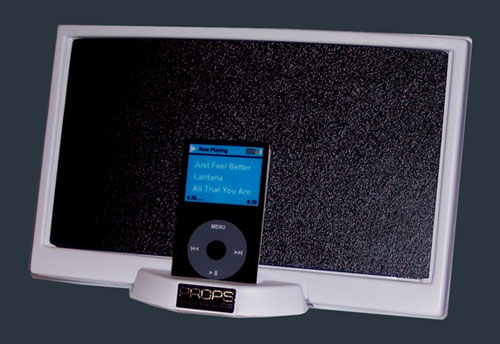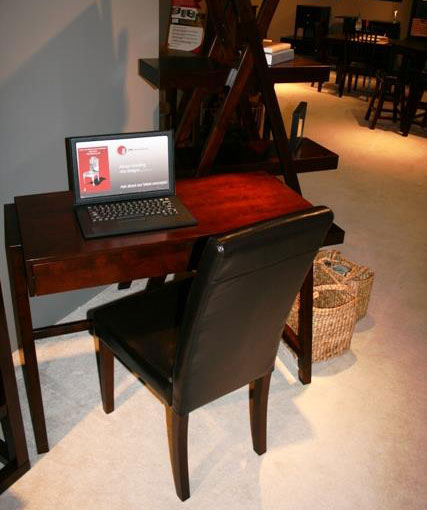Even Better Than The Real Thing
The history of the fake electronics that you sometimes see in furniture stores or in houses for sale. No, that 60-inch flat-screen TV doesn’t turn on.
Today’s GIF comes from an old Value City Furniture commercial.
Sponsored By … You?
If you find weird or unusual topics like this super-fascinating, the best way to tell us is to give us a nod on Ko-Fi. It helps ensure that we can keep this machine moving, support outside writers, and bring on the tools to support our writing. (Also it’s heartening when someone chips in.)
We accept advertising, too! Check out this page to learn more.
“Where else can you buy the likes of a fully equipped IBM PC for only $39.95?”
— A December 1983 PC Magazine article, recommending to holiday gift shoppers that they engage in “a harmless bit of computer fraud” by purchasing a prop IBM PC to fool people into thinking that your family actually purchased a computer. The “computer” was made by a company called Box Props, which came to life in 1981, was the idea of three brothers—Lou Oates, Mike Oates, and Tim Oates—who had ties to the furniture industry, with Lou owning a chain of stores that sold unfinished furniture. Per the Greensboro News & Record, the brothers had the idea of filling the “holes” in furniture wall units while enjoying an outdoor barbecue.

The unusual connection between Chicago and fake home electronics
Chicagoland is known for quite a few things—the Billy Goat Tavern, The Blues Brothers, Stern Pinball, the Brown Line, the barcades of Schaumburg, and the foul-mouthed service of The Wiener’s Circle.
But one thing it probably doesn’t get enough credit for is its role in the production of simulated electronics. During the 1980s, a number of companies showed up in the suburbs of Chicago, each promising to fill a gap in the furniture showrooms of the world.
West Chicago’s Box Props, which kicked off the trend in 1981, used cardboard to create its made-up television sets and computers, and initially had artists draw fake facades on the side. Northbrook’s Proptronics, a firm founded three years later, added plastic and a degree of realism to the equation. And Crystal Lake’s Props by IDM innovated by making its large CRTs entirely out of plastic.
A 1988 Chicago Tribune article noted that the three companies were in such a similar business that they were often mistaken for one another. Admittedly, they also influenced one another as well.
“We kind of stole the idea from the company that was making the cardboard displays,” noted Joe Barnes, the president of Props by IDM, in comments to the Tribune.
Despite the fact that their model was very specific, it was large enough to support all three companies for decades.

A 52-inch prop TV made by Props America.
These days, however, you won’t find any of them online, though a successor of sorts to Props by IDM, Props America, remains active today and is pretty hard to miss if you search for information on prop electronics in Google or elsewhere.
In an interview, Props America founder Jim Barnes noted that he launched the successor firm—located in Johnsburg, about 10 miles north of Crystal Lake—because he wasn’t ready to retire and there were shifting corporate visions at play.
“I wanted to keep working with the same people I was working with,” he said in an interview with Tedium. “I liked what I was doing, my crew was every day laughs and entertainment, and our clients were just as fun.”
While the company has its share of modern-day competitors, such as New York’s TurboProps (which also produces game consoles) and the Taiwan-based ePROP (which sells fake iPhones, complete with logo on the back), Barnes noted that the industry contracted a bit during the last recession, which directly affected some of the industry’s niches.
Another factor behind that contraction, says Barnes, is the pressure of running a U.S.-based manufacturing business in a globalized world. He noted that when he started, Illinois had many more manufacturers. Now, things have seriously contracted, though it helped that the housing market eventually bounced back, and while his company has stayed afloat thanks to diversification, it’s very much a challenging market.
“Operating a small business, especially manufacturing in the United States, can be brutal,” he noted.
$90M
The estimated value of Japan’s fake food industry, according to The Guardian. The phenomenon is particularly strong in that country, dating back to at least the 1920s as a way to allow people to order food without the use of menus. The models used by the country’s restaurant industry can often be quite complex, costing hundreds of dollars. The phenomenon, while less common in the U.S., is still prevalent. (Props America has a line of fake food.)

A molding set for a prop flat-screen television. (courtesy Props America)
What goes into making a prop television, anyway?
Wandering around the Props America website can be weirdly inspiring, in part because of the wide array of products. The pseudo-interfaces on the iPad-mimicking tablets clearly were thought through. A lot of work has done into creating products that look sort of like the real thing, but not exactly. If you walked into a showroom and saw them, you might even be briefly fooled.
Barnes, who has been producing such products for decades, notes that he takes inspiration from what’s on the shelves at actual stores.
“I scout out TV styles at Walmart, Target, BestBuy, etc. Then I come back to my shop and make a few sketches and a wooden pattern for testing,” Barnes explained. “Once I have a few samples that I like, I send the samples over to our machine shop to create the actual tools/molds to be used in production.”

Fake keyboards that have yet to be cut for fake tablets. (courtesy Props America)
That process, which usually takes four to eight weeks, has helped the company produce a wide variety of items for its customers, including 60-inch curved flat-screen televisions and laptops that actually fold shut. (The company was nice enough to send along some photos of its factory.) The company also allows you, for a price, to add the image of your choice onto the various screens that it sells.
These devices, despite not actually being functional, are very much not “cheap,” with some of the TVs that Props America sells going for more than $100—certainly not as much as an actual 60-inch TV, but definitely not a toy. That’s because it still has to look the part, and looking the part means that some functionality is required. The laptops need to have realistic-looking keyboards; the TV sets need to be able to mount onto walls.
“Weight and installation are huge for wall-mounting TVs,” Barnes explained. “Other major factors are storage and theft. Theft is a huge issue for vacant housing which accounts for a lot of our business.”

A fake iPod and speaker produced by Props by IDM.
And looking back at designs being created by other companies tells an interesting story of technological innovation. Peering at a 2012 version of the Props by IDM site brings up elaborate examples of fakery, including an iPod plugged into a speaker and a selection of fake DVDs with knockoff names like Boy Story, Claws, and American Sky.

Some of Proptronics’ fake CRTs.
Before the screens were flat, you were also likely to find prop sets built around a CRT—something that Proptronics sold as late as 2006, along with cassette decks and other home-theater niceties.
And sometimes, the props don’t even need to be electronic to be effective. The 1988 Tribune article also makes mention of Box Props producing a set of fake encyclopedias, at a time when encyclopedias were still sold in physical form.
While Props America’s line of electronics largely sticks to computers and TV sets, the company has diversified where it sells them over the years. The company’s products have been used in a variety of ways—with fake foods showing up at weddings and corporate events, and its TV screens and laptops sometimes even showing up during TV shows and music videos. That you can’t think of an obvious example just highlights how effective they are.
Barnes points to a clip of Conan on election night 2012, in which a rolling display of pundits appear on stage, each with a laptop in front of them. Those laptops? Props America originals.
While modern laptops and TV sets can’t get used in every context in a production—companies focused on props for stage productions tend to offer up actual vintage computers, rather than fake ones—having a firm like Props America at the ready is certainly a nice backup option for the stage crews of the world.
“I find peoples’ opinions to be the most interesting over the years. I will listen to them all so long as they are delivered kindly, even if they don’t like something I’ve designed. Some will be good and some not so much (laughing). Opening up and taking the opinions in has allowed me to grow and adjust.”
— Jim Barnes, discussing one of the biggest takeaways he’s learned from working in the custom display space over the years. Barnes noted that his work often doesn’t get noticed by the public, due to how obscure it really is. “Props America is in a very niche market,” he explained. “It’s also a very entertaining market.”
The thing that’s interesting about the prop electronics business is that a lot of folks, myself included, probably think about these devices in terms of furniture stores, but according to Jim Barnes, a funny thing happened over the last couple of decades: The internet.

A prop laptop, sitting on a desk. (courtesy Props America)
These days, we buy more of our furniture online, from sites like Wayfair and Amazon. That means that furniture stores aren’t quite as active on the showroom design front, and the ones that are, like Mattress Firm, are so empty that Reddit users accuse the company of being a massive money laundering scheme.
Barnes noted that this meant the company gets most of its business from the home stagers—a.k.a. the folks who swoop in on your favorite HGTV show and make the “flip” look stylish and move-in ready.
“Today most of our clients are home stagers, home builders, and realtors,” Barnes noted. “We still work with furniture stores and manufacturers but the furniture sales environment has changed drastically with e-commerce.”
In a way, that gradual shift sort of makes sense. Increasingly, these electronics are less the window dressing and more the medium from which we view the fakery—whether on television or via a website, the marketing is increasingly happening through a screen. And where’s that screen located? In your home, of course.
Unlike furniture, we usually want to see our houses before we move into them—which might just ensure that there’s a market for prop electronics well into the future.
Barnes noted that Props America draws in some collectors for its fake food, like this $12 bag of fake M&Ms. Something about this topic makes me want to collect fake computers.
You know, just in case I get sick of the real ones.
--
Find this one an interesting read? Share it with a pal! And be sure to check out my other newsletter, MidRange! I’m going to feature a guest, Eli London of the newsletter The Breads, in the next issue on Thursday.
:format(jpeg)/2018/03/tedium030818--1-.gif)
/2018/03/tedium030818--1-.gif)


/uploads/ernie_crop.jpg)